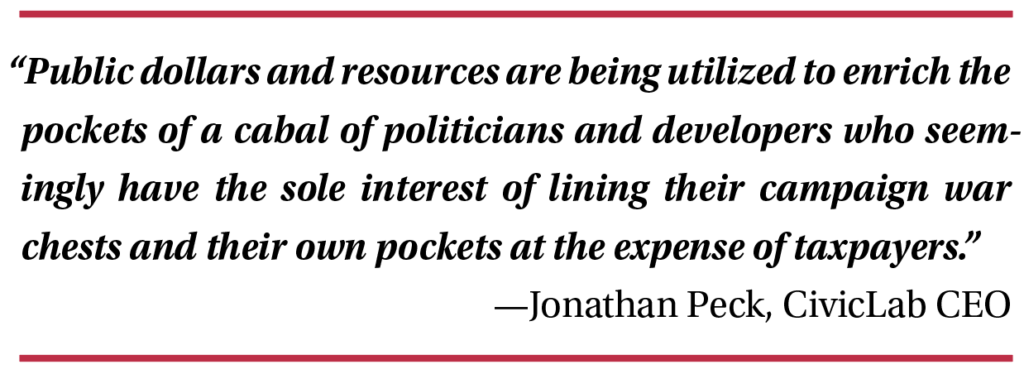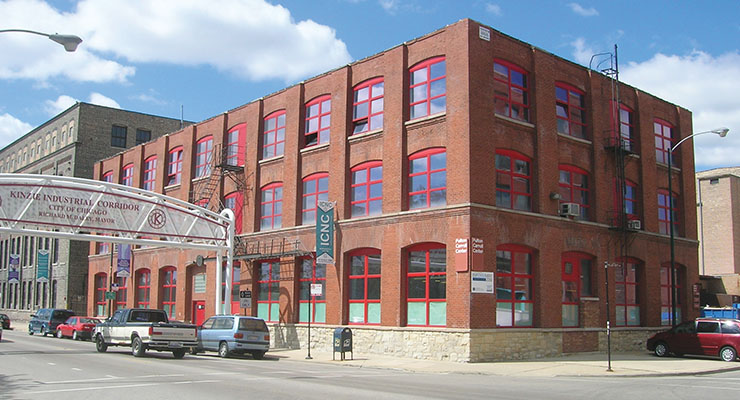By William S. Bike
Analyses by CivicLab and its TIF Illumination Project show that both the City of Chicago and State of Illinois have billions of dollars shielded in tax increment financing (TIF) accounts available to meet community needs and obligations. Yet they are not spending that fiscal bounty.
TIFs are “designed to subsidize development projects in ‘blighted’ or underserved areas,” explained Tom Tresser, CivicLab vice president and chief operating officer. When the City or State create a TIF, governments freeze the amount of taxes collected in the TIF for years, and sometimes decades, at the first year’s rate, which is known as the “base” amount. All taxes above that amount collected for the life of the TIF go to the TIF fund instead of to education and other essential public services.

“TIFs remove property taxes from the proper public flow or distribution to units of local government who rely on property taxes for operation,” CivicLab explained in a statement. “These public dollars are then doled out in an opaque and unaccountable manner to clouted developers and special projects with little or no oversight, evaluation, or possibility of redress.
“TIFs manipulate and remove hundreds of millions of dollars of property taxes annually,” CivicLab charged.
CivicLab and the TIF Illumination Project analyzed 2021 TIF figures (the most recent available) for Chicago and, along with the MuckRock Foundation, also analyzed 2020 State of Illinois TIF figures (also the most recent available).
$2 billion in Chicago
Analysis of City figures revealed $2,288,785,618 of property tax revenue sitting in Chicago’s 132 active TIF accounts—an all-time high, according to CivicLab. The total TIF extraction, “diverted from local units of government” for community needs for 2021 alone was $1,084,751,268—also “a record high” according to CivicLab. The City spent only $307,831,704 on projects that year, leaving more than $775 million unused.
The TIF with the largest balance of unspent funds diverted from community needs was the #052 Kinzie Industrial Corridor TIF, located on the Near West Side, West Haven, and West Side, which was holding $214,467,921.
“Chicago’s TIFs…have removed a staggering total of $10,254,848,248 in property taxes from 1986 through 2021,” CivicLab noted.
The biggest property tax extractor in 2021 was the #147 LaSalle Central TIF in the South Loop and Near West Side, which took in $151,520,861. “This one TIF has diverted a total of $638,411,008 in property taxes away from local units of government” since the City created it in 2006, according to CivicLab.
Although majority Black wards comprise approximately 36% of Chicago, City officials extracted 46.8% of unspent TIF funds from those wards.
The TIF Illumination Project specifically discovered that, despite billions of dollars of TIF money available, the City nonetheless paid several banks financing costs of $17,362,646 to handle TIF money.
“Our research on TIFs in Chicago revealed frequent instances of corruption, conflict of interest, and dubious projects being given public funds,” CivicLab noted.
Statewide problem
While Chicago is the biggest culprit, across the rest of Illinois, government officials are engaging in siphoning off tax dollars into TIFs as well. The MuckRock Foundation awarded CivicLab a grant of $10,000 to study TIFs across Illinois. The TIF Illumination team that worked on the project consisted of community organizers Leslie Cortez, Estefany Figureroa, and Sebastian Nails.
The study “reveals some startling numbers,” Tresser said. “Over $1.5 billion in property taxes have been removed from public circulation by Illinois’s TIF districts in 2020.”

Tresser noted that number actually is larger because CivicLab could not obtain 79 TIF reports from around the State.
“Why are these municipalities allowed to operate tax increment financing districts in complete secrecy?” CivicLab asked. “Those TIFs should be immediately frozen by the State and not allowed to capture or distribute public funds until a public, thorough, and independent audit is conducted.”
The total amount of property taxes “taken by all Illinois TIFs from 1980 through 2020 equals $25 billion,” according to CivicLab.
“Some 36 municipalities are in violation of State law, and there are apparently no meaningful penalties being enforced upon these delinquent towns and cities,” Tresser added, noting that, like Chicago, units of government across the State “collectively paid debt finance charges of $342 million” to banks.
Critics have called TIFs a “slush fund” controlled by mayors and other government officials, CivicLab noted. “Our own work substantiates this claim. We have shown here that in 2021, 52% of all the TIF funds collected in Chicago are moved out of the area where the dollars have been collected and distributed in a secretive and arbitrary manner.”
“Since our public schools are supposed to receive between 50 cents and 60 cents of every property tax dollar collected, we must conclude that TIFs bleed funds from our public education system, as well as from the other units of local government that rely on property taxes for operations,” CivicLab noted.
“Tax increment financing in Chicago is a racist, unfair, and corrupting program,” CivicLab asserted. “TIFs do not work and cannot work in any equitable manner. We call for the abolition of TIFs in Chicago and across the USA.”
CivicLab CEO Jonathan Peck added, “The CivicLab’s TIF Illumination Project continues to unearth how public dollars and resources are being utilized to enrich the pockets of a cabal of politicians and developers who seemingly have the sole interest of lining their campaign war chests and their own pockets at the expense of taxpayers. The racist and corrupt tax increment financing scheme continues to rob billions of dollars from communities across Illinois and diminish much needed public resources.”
“TIF dollars are being diverted from the public schools and public works,” said Alderman Byron Sigcho-Lopez (25th Ward), noting that, in Chicago, “we need to see changes in that, and I hope that the City Council works in cooperation with Mayor-Elect Brandon Johnson to enact reform.”
‘Piggy bank account’
“TIF funds have unfortunately been used as a ‘piggy bank account’ by mayors,” Sigcho-Lopez continued. “I think that we will expect changes from the new administration, and I hope that the City Council, especially with the large amount of new members, can take advantage of this opportunity. TIF reform is long overdue.”
Alderwoman Nicole Lee (11th Ward) is pleased by recent TIF reform and wants more.
“I have been encouraged by important reforms implemented to establish robust and vigilant oversight over TIFs in recent years,” she said. “I have also been pleased that recent budgets have fully surplussed the TIFs and allowed dollars to be directed back to original taxing bodies.
“We as a City Council must demystify TIFs and use them in the way they were intended—a way to revitalize long neglected communities,” Lee asserted. “City Council should work on sunsetting TIFs in areas where revitalization has been achieved or where it was not needed in the first place. They should be a scalpel and not a chainsaw, intended to be used sparingly and in areas most in need of investment.”
New 34th Ward Alderman Bill Conway also takes a balanced view of TIFs.
“Recognizing the checkered history the TIF program has in Chicago, I want to ensure that TIF dollars are focused on public infrastructure, green space, and public schools to improve our quality of life,” Conway said.
“However, given the unprecedented economic impact of the pandemic, TIF dollars may be required for other purposes, like revitalizing the Central Business District which runs through the new 34th Ward,” he added. “I am open to expansion and reform of TIF funds so long as projects are in the best interest of the city, its workers, and residents and the process is transparent and accountable to taxpayers.”
One fan of TIFs is 28th Ward Alderman Jason Ervin. Morgan Tadish, spokesperson for Ervin, said the alderman believes “TIFs have repeatedly proven to be a useful tool in channeling investments and improving communities. While there is still a need for reforms to promote greater transparency and accountability. TIFs are working the way they’re intended to, and the alderman will work to constantly improve them.”
CivicLab promotes civic engagement, government accountability, and social justice. MuckRock Foundation promotes government transparency and accountability.
For CivicLab information, log on to www.civiclab.us, or call (312) 566-8180. For the MuckRock Foundation, log on to www.muckrock.com.
